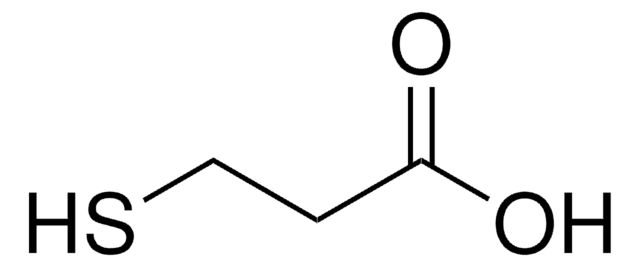409308
Tin(II) iodide
AnhydroBeads™, −10 mesh, 99.99% trace metals basis
Sinónimos:
Stannous iodide, Tin diiodide
About This Item
Productos recomendados
product line
AnhydroBeads™
assay
99.99% trace metals basis
form
beads
impurities
≤150.0 ppm Trace Metal Analysis
particle size
−10 mesh
bp
714 °C (lit.)
mp
320 °C (lit.)
density
5.28 g/mL at 25 °C (lit.)
SMILES string
I[SnH2]I
InChI
1S/2HI.Sn/h2*1H;/q;;+2/p-2
InChI key
JTDNNCYXCFHBGG-UHFFFAOYSA-L
¿Está buscando productos similares? Visita Guía de comparación de productos
General description
Application
Features and Benefits
1) Reduced uptake rate of environmental moisture minimizes caking, dusting, and static buildup for repeated easy handling.
2) Higher crucible packing densities and lower volatility in high-temperature solid state procedures.
3) Easier pneumatic loading of salts to sample chambers due to less clogging issues associated with powdered salt counterparts.
Legal Information
For use with
signalword
Danger
Hazard Classifications
Acute Tox. 4 Inhalation - Acute Tox. 4 Oral - Eye Dam. 1 - Met. Corr. 1 - Skin Corr. 1B - Skin Sens. 1 - STOT RE 2 - STOT SE 3
target_organs
Cardio-vascular system,hematopoietic system, Respiratory system
Storage Class
8A - Combustible corrosive hazardous materials
wgk_germany
WGK 3
flash_point_f
Not applicable
flash_point_c
Not applicable
ppe
Eyeshields, Faceshields, Gloves, type P2 (EN 143) respirator cartridges
Certificados de análisis (COA)
Busque Certificados de análisis (COA) introduciendo el número de lote del producto. Los números de lote se encuentran en la etiqueta del producto después de las palabras «Lot» o «Batch»
¿Ya tiene este producto?
Encuentre la documentación para los productos que ha comprado recientemente en la Biblioteca de documentos.
Los clientes también vieron
Nuestro equipo de científicos tiene experiencia en todas las áreas de investigación: Ciencias de la vida, Ciencia de los materiales, Síntesis química, Cromatografía, Analítica y muchas otras.
Póngase en contacto con el Servicio técnico















